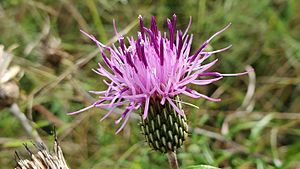Cirsium lecontei facts for kids
Quick facts for kids Cirsium lecontei |
|
|---|---|
| Scientific classification | |
| Genus: |
Cirsium
|
| Species: |
lecontei
|
| Synonyms | |
|
|
Cirsium lecontei, often called the Le Conte's thistle, is a special plant found in North America. It grows in the southeastern United States. This plant is usually a perennial, meaning it lives for many years. Sometimes, it can be a biennial, living for two years. Le Conte's thistle is part of the sunflower family. You can find it along the coastal plain, from Louisiana to North Carolina. It usually blooms from spring to summer.
About Le Conte's Thistle
Le Conte's thistle can grow quite tall, from about 35 to 110 centimeters (that's about 1 to 3.5 feet!). It has a main root that goes deep into the ground, called a taproot. Sometimes, new plants can even sprout from its roots.
This plant has spines, so you need to be careful when touching it! Its flowers are usually a pretty pink color. Le Conte's thistle loves lots of sunshine. It often grows in wetlands, which are areas with wet soil. This is why its Wetland Indicator Status is FACW. This means it usually grows in wetlands, but not always.
The stems of the plant are a bit hairy, like a spiderweb, and they grow straight up. The leaves are long and narrow. When they are young, they also have these web-like hairs. As the plant gets older, the leaves become smooth. The leaves at the bottom of the plant sometimes disappear when it flowers. The flowers grow either alone or in small groups of 2 to 10. They are held high above the rest of the plant. The seeds are light brown and about 5 to 5.75 millimeters long. The pinkish-purple petals have feathery bristles, which help the seeds fly away.
Where It Grows
Le Conte's thistle likes sandy soil in pine forests along the southern coast. It grows in damp places. You can find it in states like Alabama, Florida, Georgia, Louisiana, Mississippi, North Carolina, and South Carolina. It also likes wet, grassy pine areas, bogs (which are like spongy wetlands), and even ditches along roads. In these places, it might grow alongside other plants like pitcher plants, holly, and different kinds of grasses.
Why It's Threatened
Le Conte's thistle is not very common. Even in North Carolina, where it's found most often, it's still rare. It's also rare in other states like South Carolina, Florida, and Louisiana. Sometimes, you might only find one plant in an area!
There are a few reasons why this plant is becoming rare:
- Changing its home: People are turning the plant's natural habitat into pine tree farms. This can involve preparing the land in ways that hurt the thistle, like using special machines or chemicals.
- Wrong fire times: Natural fires are important for some habitats, but if fires happen at the wrong time, they can harm the thistle.
- Building new things: More and more land is being used for homes and businesses. This means less space for plants like Le Conte's thistle to grow.
How It Came to Be
Scientists think that Le Conte's thistle might have formed a long, long time ago. They believe it could be a mix of two other types of thistles: C. horridulum and C. nuttallii. Some scientists also think it might be related to C. grahamii, which grows in Arizona. They wonder if the plant's ancestors traveled a very long time ago from the southeastern coast all the way to the western mountains.


